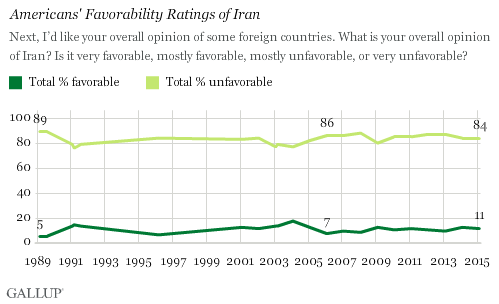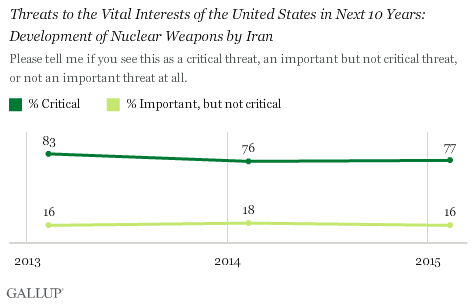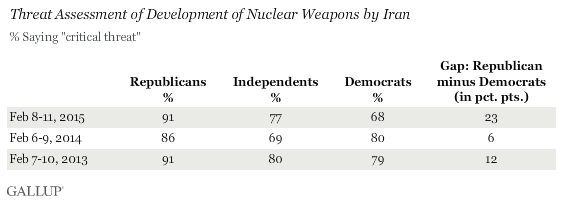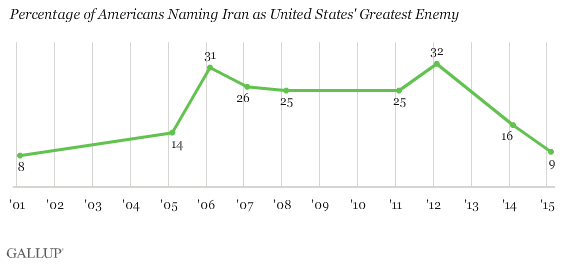Story Highlights
- Consistent with past years, 11% see Iran favorably
- 77% say potential Iranian nukes are a critical threat
- Republicans far more likely to say Iran is critical threat
WASHINGTON, D.C. -- As the United States and several other nations continue to negotiate what would be a landmark agreement to limit Iran's production of nuclear weapons, more than eight in 10 Americans view Iran unfavorably (84%). Only 11% have a favorable view of the country. Despite this potential thaw in Iranian-U.S. relations, Americans' views on its long-time foe have remained unchanged for 26 years.

Iran's historical favorable average of 11% is the lowest of 22 countries Gallup asked about in this year's World Affairs poll, conducted Feb. 8-11 -- a list that includes such prominent U.S. adversaries as Russia, Syria and North Korea.
Since the Islamic Revolution of 1979 toppled the pro-U.S. government in Iran, the two countries have been antagonists, and this has been borne out in U.S. public opinion. When Gallup first asked Americans to rate Iran, in 1989, 5% said they saw the country favorably.
Over the past decade, however, U.S.-Iranian relations have developed an unexpected element of intrigue. In January 2002, then-President George W. Bush famously included Iran -- along with North Korea and an Iraq then controlled by Saddam Hussein -- in what he called "an axis of evil," though Bush's inclusion of Iran in this trio did nothing to damage that nation's already battered standing with Americans. After the American-led invasion of Iraq that altered the political order in the Middle East, Iranian political influence in countries such as Iraq, Lebanon and Syria appeared to grow, often compromising the United States' influence in these places. Furthermore, not long after Iranian President Mahmoud Ahmadinejad -- an outspoken U.S. critic -- began the first of his two terms as president, a plurality of Americans in 2006 named Iran as America's greatest enemy, a spot it retained for much of Ahmadinejad's presidency.
But more recent events have suggested the two countries may find a way to move beyond this, perhaps to better relations. In 2013, Iranians elected President Hassan Rouhani, a candidate who has publicly stated he is open to working with the U.S. on some matters. With the rise of the Islamic State group in Iraq last year, Iran and the U.S. now have a rare common cause, since neither country is interested in seeing the terrorist group prosper. Meanwhile, the Obama administration has joined other nations in negotiations with Iran aimed at limiting that nation's nuclear program in exchange for relief from economic sanctions.
These efforts may soon bear fruit with some type of multinational agreement, though any deal would not be without its share of congressional critics. And given Iran's low favorability with the American people, it could be a hard sell beyond the halls of Capitol Hill.
Iran's Development of Nuclear Weapons Seen as Critical Threat
Nonetheless, the vast majority of Americans (77%) say the development of nuclear weapons by Iran is a "critical threat," perhaps underscoring the importance of these talks. Another 16% say the threat is important, but not critical. Since 2013, a preponderance of U.S. adults have identified possible Iranian nuclear weapons as a critical threat and the issue has ranked highly compared with other possible threats facing the U.S.

But as the prospect of an agreement -- though still far from certain -- increases, Democrats are notably less likely to classify the development of an Iranian nuclear bomb as a critical threat compared with Republicans or even with Democratic responses in prior years. Today, 68% of Democrats say Iranian nuclear weapons would be a critical threat, compared with 91% of Republicans. This formidable 23-percentage-point gap, among the highest for the eight threats measured in the Gallup survey, was virtually nonexistent last year, when 86% of Republicans and 80% of Democrats viewed this as a critical threat.
In 2013, the gap between the parties was also a less pronounced one, at 12 points.

Fewer See Iran as America's Greatest Enemy
While Americans see Iran no more favorably today than in years past, fewer (9%) in an open-ended question name it as America's greatest enemy, down almost half from last year (16%) and a nearly fourfold drop from the measure's 2012 high (32%). This year, Russia, North Korea and China were all named with more frequency than Iran.

Since Rouhani ascended into office in 2013, fewer Americans have named Iran as their country's biggest enemy. Even if Rouhani's tenure has not seen more Americans view Iran favorably, fewer see it as the nation's main opponent.
Bottom Line
Along with five other nations, U.S. and Iranian negotiators are working to reach an accord satisfactory to all parties. But any agreement will have the herculean task of overcoming a generation's worth of mutual enmity, feelings that are at least partially evident in Americans' low favorable rating of Iran. This is not to say public opinion is immutable -- Cuba saw its favorable rating spike by eight points this year in the wake of its announced détente with the U.S. -- but attitudes toward Iran may prove a weight on U.S. negotiators and will be reflected in Congress' reaction to any deal. At the same time, stopping Iran from developing a nuclear bomb is a pressing priority for most Americans, meaning policymakers who reject a deal out of hand could feel pressure to promote another solution.
Survey Methods
Results for this Gallup poll are based on telephone interviews conducted Feb. 8-11, 2015, with a random sample of 837 adults, aged 18 and older, living in all 50 U.S. states and the District of Columbia. For results based on the total sample of national adults, the margin of sampling error is ±4 percentage points at the 95% confidence level. All reported margins of sampling error include computed design effects for weighting.
Each sample of national adults includes a minimum quota of 50% cellphone respondents and 50% landline respondents, with additional minimum quotas by time zone within region. Landline and cellular telephone numbers are selected using random-digit-dial methods.
View survey methodology, complete question responses, and trends.
Learn more about how Gallup Poll Social Series works.

